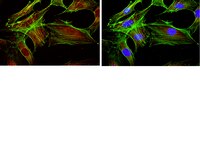Liraglutide improves pancreatic Beta cell mass and function in alloxan-induced diabetic mice.
Tamura, K; Minami, K; Kudo, M; Iemoto, K; Takahashi, H; Seino, S
PloS one
10
e0126003
2015
Mostra il sommario
Glucagon-like peptide-1 (GLP-1) receptor agonists potentiate glucose-induced insulin secretion. In addition, they have been reported to increase pancreatic beta cell mass in diabetic rodents. However, the precise mode of action of GLP-1 receptor agonists still needs to be elucidated. Here we clarify the effects of the human GLP-1 analog liraglutide on beta cell fate and function by using an inducible Cre/loxP-based pancreatic beta cell tracing system and alloxan-induced diabetic mice. Liraglutide was subcutaneously administered once daily for 30 days. The changes in beta cell mass were examined as well as glucose tolerance and insulin secretion. We found that chronic liraglutide treatment improved glucose tolerance and insulin response to oral glucose load. Thirty-day treatment with liraglutide resulted in a 2-fold higher mass of pancreatic beta cells than that in vehicle group. Liraglutide increased proliferation rate of pancreatic beta cells and prevented beta cells from apoptotic cells death. However, the relative abundance of YFP-labeled beta cells to total beta cells was no different before and after liraglutide treatment, suggesting no or little contribution of neogenesis to the increase in beta cell mass. Liraglutide reduced oxidative stress in pancreatic islet cells of alloxan-induced diabetic mice. Furthermore, the beneficial effects of liraglutide in these mice were maintained two weeks after drug withdrawal. In conclusion, chronic liraglutide treatment improves hyperglycemia by ameliorating beta cell mass and function in alloxan-induced diabetic mice. | 25938469
 |
SREBP-1 transcription factors regulate skeletal muscle cell size by controlling protein synthesis through myogenic regulatory factors.
Dessalle, K; Euthine, V; Chanon, S; Delarichaudy, J; Fujii, I; Rome, S; Vidal, H; Nemoz, G; Simon, C; Lefai, E
PloS one
7
e50878
2011
Mostra il sommario
SREBP-1 are ubiquitously expressed transcription factors, strongly expressed in lipogenic tissues where they regulate several metabolic processes like fatty acid synthesis. In skeletal muscle, SREBP-1 proteins regulate the expression of hundreds of genes, and we previously showed that their overexpression induced muscle atrophy together with a combined lack of expression of myogenic regulatory factors. Here we present evidences that SREBP-1 regulate muscle protein synthesis through the downregulation of the expression of MYOD1, MYOG and MEF2C factors. In myotubes overexpressing SREBP-1, restoring the expression of myogenic factors prevented atrophy and rescued protein synthesis, without affecting SREBP-1 action on atrogenes and proteolysis. Our results point out the roles of MRFs in the maintenance of the protein content and cell size in adult muscle fibre, and contribute to decipher the mechanisms by which SREBP-1 regulate muscle mass. | 23226416
 |













